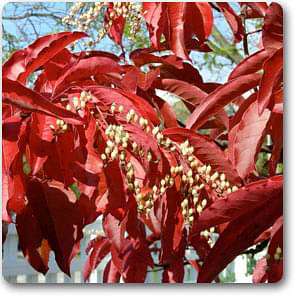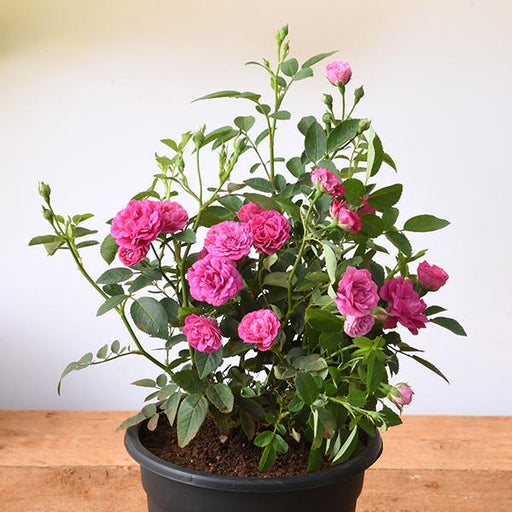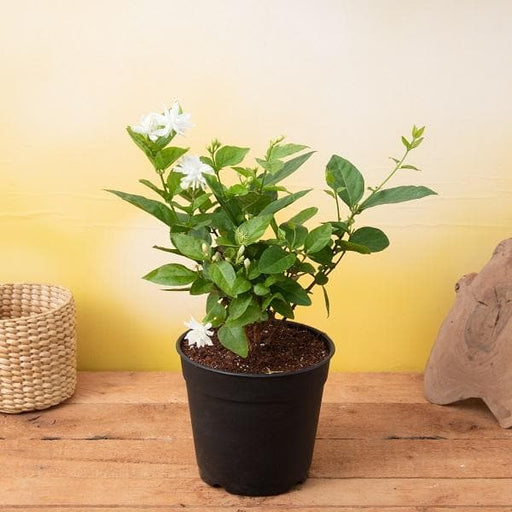
Sourwood - Plant
(MRP Inclusive of all taxes)
- Shipping ₹79 for entire order
- Dispatch in 7 days
- Country of origin: India

(MRP Inclusive of all taxes)
 Save 29%
Save 29%
Air Purifier Money Plant with Pot The Air Purifier Money Plant, also known as Pothos or Epipremnum aureum, is a stunning indoor plant that...
View full details
 Save up to 15%
Save up to 15%
Peace Lily, Spathiphyllum - Plant The Peace Lily, scientifically known as Spathiphyllum, is a stunning houseplant celebrated for its elegant white...
View full details
 Save 25%
Save 25%
Jasminum sambac, Mogra, Arabian Jasmine - Plant Jasminum sambac, commonly known as Mogra or Arabian Jasmine, is a fragrant flowering plant...
View full details
 Save 18%
Save 18%
Combo Constituents Includes the Parijat Tree (Night-Flowering Jasmine), a culturally significant plant with fragrant flowers. Description The Pari...
View full details
 Save 25%
Save 25%
Miniature Rose, Button Rose (Any Color) - Plant The Miniature Rose, also known as the Button Rose, is a charming and compact flowering plant that ...
View full details Save 25%
Save 25%
Damascus Rose, Scented Rose (Any Color) - Plant The Damascus Rose, also known as Rosa damascena, is a timeless symbol of beauty and romanc...
View full details
 Save 17%
Save 17%
Beautiful Fragrant Mogra, Arabian Jasmine Plant with Pot The Beautiful Fragrant Mogra, also known as Arabian Jasmine (Jasminum sambac), is...
View full details Save 15%
Save 15%
Pack of Vermicompost and Neem Cake for House Plants Transform your indoor garden with our premium Pack of Vermicompost and Neem Cake, spec...
View full details
Pack of Plant Growth and Flower Boosters Unlock the full potential of your garden with our Pack of Plant Growth and Flower Boosters! This ...
View full details Save 38%
Save 38%
Combo of Jeevamrut and Neem Raksha for Easy Growth and Protection of Houseplants Transform your indoor garden with our exclusive combo of ...
View full details Save 22%
Save 22%
Plant Nutrients Kit (Pack of 16) for a Healthy Garden Transform your garden into a lush paradise with our Plant Nutrients Kit, featuring 1...
View full details Save 16%
Save 16%
Combo of Top Plant Fertilizers Elevate your gardening game with our exclusive Combo of Top Plant Fertilizers, featuring two bags of premiu...
View full details Save 24%
Save 24%
Pack of 4 Additives to Make Soil Healthy and Nutrient Rich Transform your garden into a thriving ecosystem with our Pack of 4 Additives de...
View full details Save 30%
Save 30%
Transform your gardening experience with our premium Combo of Perlite and Vermiculite. This unique blend is designed to enhance soil aeration and ...
View full details Save 27%
Save 27%
Combo of 2 Vermicompost and Cocopeat - Enrich Your Soil Naturally! Transform your garden into a thriving ecosystem with our Combo of 2 Ver...
View full details
 Save 35%
Save 35%
Best 6 Plants for Perfect Indoor Garden Transform your living space into a lush oasis with our curated collection of the Best 6 Plants for a...
View full details
 Save up to 50%
Save up to 50%
Mini Succulent Garden Pack Transform your space with our Mini Succulent Garden Pack, featuring a delightful collection of 4 any variety beautiful s...
View full details
 Save 30%
Save 30%
5 Best Fragrant Plants Transform your garden or indoor space into a fragrant paradise with our curated selection of the 5 Best Fragrant Plants. Th...
View full details
 Save 24%
Save 24%
Set of 2 Bonsai Looking Grafted Adeniums Transform your indoor or outdoor space with our exquisite Set of 2 Bonsai Looking Grafted Adenium...
View full details Save 45%
Save 45%
Top 4 Die Hard Succulents Pack Transform your indoor or outdoor space with our Top 4 Die Hard Succulents Pack, featuring a curated selecti...
View full details
 Save 30%
Save 30%
5 Best Indoor Plants Pack Transform your living space into a lush oasis with our '5 Best Indoor Plants Pack.' This carefully curated collection fe...
View full details
 Save 25%
Save 25%
Set of 4 Evergreen Air Purifier Plant Pack Transform your indoor space into a lush, green oasis with our Set of 4 Evergreen Air Purifier Pla...
View full details| SrNo | Item Name |
|---|---|
| 1 | Sourwood - Plant |
The Sourwood (Oxydendrum arboreum) is a stunning deciduous tree native to the southeastern United States, renowned for its striking foliage and fragrant white flowers. This unique plant thrives in acidic soils and is often found in mountainous regions, making it a favorite among gardeners seeking to add a touch of elegance to their landscapes. The Sourwood tree is not only visually appealing but also plays a vital role in local ecosystems, supporting various wildlife species.
What makes the Sourwood special is its ability to produce a highly sought-after honey, known for its distinct flavor and health benefits. The tree's leaves turn a brilliant red in the fall, providing a spectacular display that enhances any garden. Additionally, Sourwood is a hardy plant that can withstand drought conditions, making it an excellent choice for sustainable landscaping.
One of the standout features of the Sourwood is its unique flowering pattern. The tree produces clusters of bell-shaped white flowers in mid-summer, attracting bees and other pollinators, which are essential for maintaining biodiversity. This not only benefits the environment but also supports local honey production, making it a valuable addition to any garden.
The Sourwood tree plays a significant role in its ecosystem by providing habitat and food for various wildlife species. Its flowers are a vital nectar source for bees, contributing to the health of local bee populations and promoting biodiversity. By planting Sourwood, you are not only enhancing your garden but also supporting the environment and local ecosystems.
If you’re looking for a tree that’s not just a pretty face, the Sourwood tree is your go-to! This beauty offers a plethora of benefits, from its stunning fall foliage to its sweet nectar that bees absolutely adore. Imagine planting a tree that not only beautifies your yard but also supports local wildlife. Plus, the honey produced from Sourwood nectar is a gourmet delight. Talk about a win-win!
Caring for a Sourwood tree is like nurturing a diva; it requires attention but rewards you handsomely. These trees thrive in well-drained, acidic soil and love a good sunbath. Regular watering during dry spells keeps them happy, and a little pruning here and there ensures they maintain their elegant shape. Treat them right, and they’ll reward you with breathtaking blooms and vibrant autumn colors.
Patience is a virtue, especially when it comes to the growth rate of the Sourwood tree. These slow and steady growers can take their sweet time, reaching maturity in about 10 to 15 years. But don’t fret! The wait is worth it, as they eventually grow into majestic specimens that can reach heights of up to 30 feet. So, grab a chair, sit back, and enjoy the show as your Sourwood tree takes its time to shine.
The Sourwood tree is a true Southern belle, thriving in the warm, humid climates of the southeastern United States. It loves to hang out in well-drained, acidic soils, often found in the company of other hardwoods. This tree is a master of adaptation, making it a perfect fit for various landscapes. Whether you’re in a forest or a backyard, the Sourwood tree knows how to make itself at home.
The Sourwood tree isn’t just a pretty face; it’s a multitasker! Beyond its ornamental value, it’s a favorite among beekeepers for its sweet nectar, which produces some of the finest honey around. Its wood is also prized for its durability and beautiful grain, making it a popular choice for furniture and crafts. So, whether you’re looking to beautify your garden or sweeten your tea, the Sourwood tree has got you covered.
When it comes to pollination, the Sourwood tree knows how to throw a party! Its fragrant white flowers attract a bevy of pollinators, especially bees, who can’t resist the sweet nectar. This tree is a vital player in the ecosystem, supporting not just bees but also butterflies and other beneficial insects. So, plant a Sourwood tree and watch as your garden transforms into a buzzing hub of activity!
If you want your Sourwood tree to thrive, you better roll out the red carpet of acidic, well-drained soil! This tree is quite particular about its living conditions, preferring a pH between 4.5 and 6.0. Sandy or loamy soils are its favorites, so if your yard is more clay than cake, you might need to do some soil amendments. Give it the right foundation, and it’ll reward you with stunning growth and vibrant blooms.
The Sourwood tree is like the wise old sage of the forest, boasting a lifespan of up to 100 years! That’s right; this tree is in it for the long haul. With proper care, it can stand tall and proud for generations, providing shade, beauty, and sweet nectar for years to come. So, when you plant a Sourwood tree, you’re not just planting a tree; you’re planting a legacy.
Every diva has her detractors, and the Sourwood tree is no exception. While generally resilient, it can occasionally attract pests like aphids and scale insects. But fear not! A little vigilance and some organic pest control can keep these nuisances at bay. With a bit of TLC, your Sourwood tree will remain the belle of the ball, free from unwanted guests.
Pruning a Sourwood tree is like giving it a stylish haircut; it keeps it looking fabulous! Regular pruning helps maintain its shape and encourages healthy growth. The best time to prune is in late winter or early spring before the new growth begins. Just remember to wield your pruning shears with care, as you want to enhance its natural beauty, not turn it into a topiary disaster.
Incorporating a Sourwood tree into your landscape design is like adding a splash of color to a black-and-white movie. Its stunning fall foliage and unique flowers can elevate any garden. Whether you’re looking for a focal point or a natural privacy screen, the Sourwood tree fits the bill. Pair it with complementary plants, and you’ll create a picturesque scene that even Mother Nature would envy.
Sourwood is a delightful deciduous tree known for its stunning fall foliage and sweet nectar. Native to the eastern U.S., it’s a favorite among bees, producing honey that’s as sweet as a summer romance. With its unique name, it’s sure to spark conversations at your next garden party!
Sourwood thrives in well-drained, acidic soils, typically found in the Appalachian region. It loves a sunny spot but can tolerate some shade, making it the diva of the forest. Just remember, it’s not a fan of soggy feet—so keep those roots dry and happy!
Sourwood can reach heights of 30 to 50 feet, making it a majestic addition to any landscape. With its graceful, slender trunk and beautiful canopy, it’s like the elegant model of the plant world. Just be prepared for some serious neck craning when you admire its height!
Sourwood offers a buffet of benefits: stunning fall colors, fragrant flowers, and honey production. It’s a bee magnet, attracting pollinators like a celebrity at a red carpet event. Plus, its wood is prized for furniture, making it a multitasking marvel in the garden!
Sourwood is not the top choice for deer, making it a savvy pick for your garden. While they might nibble on the occasional leaf, they generally prefer more delectable options. So, plant with confidence—your Sourwood will stand tall, even when the local deer are on the prowl!
Sourwood blooms in late spring to early summer, showcasing clusters of fragrant white flowers. These blooms are like nature’s confetti, attracting bees and butterflies to your garden party. Just imagine the buzz—literally—when your Sourwood puts on its floral show!
Caring for Sourwood is a breeze! Plant it in well-drained, acidic soil, and give it a sunny spot. Water it during dry spells, but don’t drown it—this diva prefers a light touch. Prune as needed to maintain its shape, and watch it thrive like a superstar!
Sourwood is somewhat drought-tolerant once established, but it prefers a little moisture. Think of it as a plant that enjoys a spa day but can survive a few skipped treatments. Just ensure it has well-drained soil, and it’ll be happy to weather the dry spells!
Sourwood can fit into small gardens, but be mindful of its height. Consider dwarf varieties or plant it where it has room to stretch its limbs. With its stunning foliage and fragrant blooms, it’ll be the showstopper in your cozy garden space!
Sourwood loves acidic, well-drained soil—think of it as the plant equivalent of a fancy restaurant. It’s not a fan of heavy clay or overly wet conditions, so make sure to serve it the right soil mix. Your Sourwood will thank you with vibrant growth!
Sourwood has a moderate growth rate, typically adding 1 to 2 feet per year. It’s not a speed demon, but it’s not a sloth either! With a little patience, you’ll soon enjoy its stunning beauty and the sweet rewards it brings to your garden.
While Sourwood prefers to stretch its roots in the ground, it can be grown in pots for a while. Just ensure the pot is large enough and has good drainage. Keep in mind, though, it may eventually want to break free and find a permanent home in your garden!